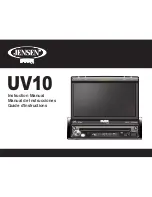
Adjustments
Attenuator:
Decrease signal strength (output dBmV) of modulator.
Stereo Loop:
Used to pass stereo to TV on non-stereo modulator.
75
Ω
position is normal, 1K
Ω
position if using stereo loop.
Video Level Adjustment:
Adjust the incoming video source base
band level. Use only to increase brightness and balance the
channels for consistent contrast. Spectrum analyzer use is
suggested.
Channel Select
: Used to select the input source (A, B or C), you
wish to change. Also has a lockout feature to prevent the end user
from changing channels. Press and hold for 2 seconds or until
front light blinks to allow channel up/down to work.
Channel Up/Down
: Changes the modulated channel.
DIP Switch Setting
: Selection of TV frequency band.
UHF = Antenna, Ultra = Cable.
System Installation Checklist
1.
Try for 10dB of signal strength at each television. Use a little
more for big screen TV's. Remember, Uncle Sam doesn't like
more than 15.5dB of signal going into any TV.
2.
When laying out your system, there will be approximately 5dB of
signal loss per 100' of RG6.
3.
Be sure ALL of your splitters and amplifiers are broadband.
Splitters should be 5MHz to 1GHz, and amps should be 40MHz
to 1GHz.
4.
Check and make sure that all television are set up for the proper
frequency spectrum (i.e. UHF or cable).
5.
Make sure that the channels you want to modulate on have clean
"snow". No lines or interference.
6.
Use a low pass filter on every installation to clean up the
frequencies the modulator will be assigned to and keep any
potential interference out of the system. Model 3102, cleans up
channel 80 and above.
7.
Allow 1 to 2 channel spacing between modulated channels and
"active" channels.
8.
Always compensate for insertion loss with splitters and taps.
There will always be a drop in antenna/cable signal strength
when combining a modulator to an existing system (because of
insertion loss with the combiner).
9.
When combining an existing signal with a modulated signal,
make sure to have equal signal strength at the point of the
combiner so one signal does not degrade the other and cause beat
frequencies.
10. When possible, use the lowest frequencies available for the
modulated channels. Lower channels (frequencies) have lower
signal loss on the cable runs.
11. When in doubt, run the signal a little high to the television and
use an attenuator to lower the signal strength going into the TV.
Attenuators may be combined (i.e. two -3dB attenuators will
equal -6dB).
12. Make sure to use a well shielded coax of either RG6 Quad or
RG11 for RF distribution systems.
13. Use RG59U Coax for composite/baseband video signals only.
14. Combine the modulator into the video distribution system as far
"up-stream" as possible.
15. If the system needs to be amplified use the amplifier as far "up-
stream" as possible.
Trouble Shooting
Trouble shooting any system can make or break the entire
installation. Here are the most common problems and solutions.
After trying these solutions, call (800) 840-0288 for 24 hour
technical assistance. Calls before 8 a.m. and after 5 p.m. pacific
standard time will be returned by the technician on call.
Stops Modulating : No Modulation
Modulator requires proper ventilation for long life reliability and
continued operation. Unplug unit, let it cool down, install in
well ventilated area to continue operation.
Snowy Picture : No Modulation
This is a problem of the TV and the modulator not "talking" to each
other.
1.
Verify the modulator is set up for the proper TV channel band.
If cable TV or antenna? If the unit uses dip switches to set the
channel band, was the unit powered down during or after the
switches were reset to the proper band? If the unit uses a
jumper check for proper placement.
2.
Verify the TV is set up on the proper TV channel band. Use
"Air" for UHF channels or Cable for Ultraband channels . The
TV will have an on screen set-up menu or a switch for this
function. Also make sure the modulated channel isn't blocked
out by auto-programming. To check for the TV being set to the
wrong band, go to the equivalent channel on the other band (i.e.
to check 65 cable try 14 UHF). Add 51 channels for antenna
connection to cable channels.
3.
Check TV manual to make sure TV works on channels above
65.
4.
Check all connections for a good connection.
5.
Check splitters and amplifiers for 1GHz rating.
6.
Try another TV, bypass all components and go directly into TV.
Black Picture : No Modulation
In this case, the TV and the modulator are "talking" to each other.
The video signal is not being passed through the system.
1.
Verify good connections to the modulator from the video source
i.e. VCR.
2.
Check video source (VCR, Sat Receiver etc.) by running the
outputs directly into the video inputs on the TV. Verify video
source is working.
3.
Check for power at video source.
4.
Disconnect modulator from system:
A) Picture goes to snow, problem is between video source and
inputs on the modulator.
B) Picture stays black, hook up the modulator directly to a TV
eliminating all the components of the system and check the
picture.
Grainy Local Channels : Good Modulated Picture
1.
Disconnect the modulator from the system and connect the local
channel feed directly to the distribution system and check TV picture
quality.
A) If the picture quality is good the insertion loss of the
combiner for the modulator is degrading the local channel
signal. Use a CVT-15PIA to compensate for the insertion
loss.
B) The other alternative is to use a 6dB tap as the combiner, put
the local channel feed on the pass through port for a minimal
loss of signal connect the modulator to the tap off port.
C) If the picture is still bad, check for a bad connection where
leakage may occur or if the shielding braid is touching the
center conductor.
2.
Install model CVT-15PIA amplifier on the incoming cable
before the combiner. See basic schematic.
Grainy Modulated Channel : Good Picture on the Cable
Channels
1.
Disconnect cable channels from the system and check the



























